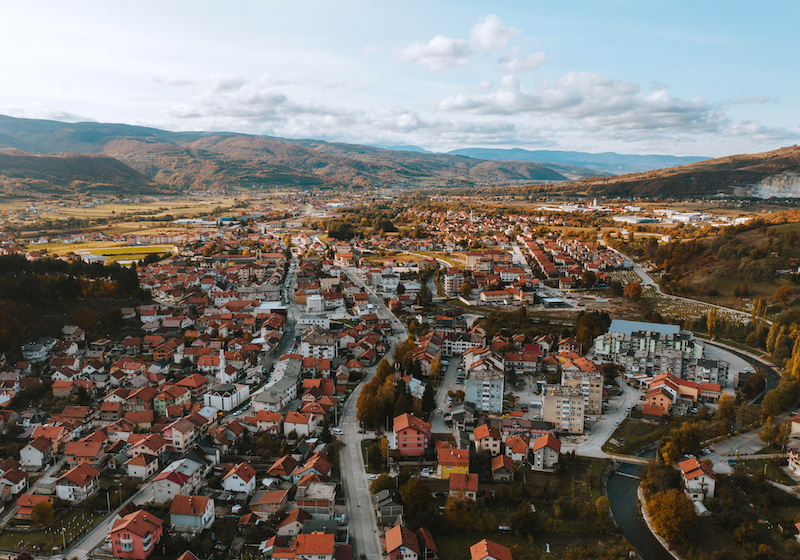Srebrenica on screen: Jasmila Žbanić’s Quo Vadis, Aida? wrestles with the history of genocide in the heart of Europe
Shortlisted for Oscars, this profoundly moving drama shows how war can destabilise and destroy thousands of lives in the blink of an eye.
Quo Vadis, Aida?, the latest drama by 2006 Golden Bear winner Jasmila Žbanić, traces a still open wound in the heart of the Balkans: the 1995 Srebrenica massacre. Penned by the director herself, the story follows Aida Selmanagić (played by an extraordinary Jasna Đuričić), a teacher-turned-translator working for the local United Nations camp in Srebrenica during the Bosnian War. When the Serbian army, led by General Ratko Mladić (Boris Isaković), takes over the area on 11 July 1995, Aida’s family is among the thousands of refugees protected by the UN’s Blue Berets. As a translator, however, Aida herself ends up navigating a delicate tightrope between the civilians, their appointed protectors, and the advancing Serbian forces. Her work allows her to take part in the bungled negotiations on the fate of the civilians grouped in the camp. Officially, an agreement is reached that should guarantee refugees safe passage from the area as UN peacekeepers move back. Instead, the Serbian army begins separating men and boys from women and children (many of the latter boarded on buses to never see their loved ones again), and launches a series of brutal massacres, murdering more than 8,000 Bosniak Muslims.
Žbanić remembers the wild disbelief she went through at the time of the tragedy. To prepare the film, she read through stacks of books and interviewed many people: extra attention has been paid to the painful stories told by women from Srebrenica, who have long hoped to find their sons alive in the years following the massacre. “Initially, I didn’t think about making a film, I was hoping somebody else would. I thought it was too big, and risky project. After I made four fiction films, I felt I was ready to explore this subject and I started looking for a direction to take,” the director told the The Calvert Journal at a meeting after the film’s recent showing in the Limelight strand of this year’s International Film Festival Rotterdam.
“I realised that my goal was to help the audience to identify with those people, and to focus on the human dimension of the story, rather than on the political one. It’s been a long production process, which took about five years, and involved nine co-production countries,” she says.
An incredibly tense vision for most of its running time, Žbanić’s film often chooses to follow her characters through the frenetic shots of a steadicam, giving a strong sense of immediacy, and evoking the chaos among the refugees and the Dutch soldiers in charge of the base, headed by the torn Colonel Thom Kerremans (Johan Heldenbergh). The picture dissects how the situation deteriorates from bad to worse in the course of just a few days, leaving viewers with the overwhelming sense of powerlessness felt by the UN forces, and the increasing desperation of the refugees.
It is still difficult to believe that such a genocide took place 25 years ago, in the heart of Europe, and that nothing was done to de-escalate the crisis. It is that feeling of disbelief which has pushed Žbanić to depict just how quickly everyday life can be destroyed. She also shows us how quickly brutality can surface, often in the most surreal of fashions, leaving us indifferent. This concept is particularly visible in two scenes of the film. The first portrays the dead body of a woman lying next to a toy helicopter, while her dog runs away and a meal burns in the oven; the second is set close to a school gym where some of the executions take place. From the distance, it shows people sitting on their balconies and a group of boys playing football, until they later get scared by the sudden gunshots.
Choosing the right lead actors — and developing their roles — has been a crucial part of Žbanić’s efforts to create a realistic tale. “When I started casting roles, I had Jasna Đuričić as Aida in mind. I’ve worked with her in the past and knew her previous film and theatre work. The script was almost finalised when we had a filmed table-read, attended by the main cast. After that read-through, I adapted the script to my actors and adjusted its pace,” she says.
Filming on location in Srebrenica was not an option — not least because the town’s current mayor denies that the genocide ever took place. Žbanić took her team to southern Bosnia. “We spent a few days in an apartment and built up the whole life of the family prior to the outbreak of the war; how Aida and her husband Nihad [Izudin Bajrović] met, when they married, how they rented the apartment and furnished it, the birth of their sons Hamdija [Boris Ler] and Sejo [Dino Bajrović] and so on,” she says. “We improvised all of these events in order to help the actors feel like a real family on set.”
“I became so obsessed with the question: why didn’t somebody do something?”
But Žbanić also felt the impact of the film off-set too. “[Recently,] I was at Vienna airport,” she says. “There was a boy [travelling alone] who had been stopped by a flight attendant; it was about 10pm. [The boy] was probably 10-years-old and had travelled from Ireland to visit his grandparents, but didn’t have a Bosnian visa. The flight attendant told him he’d have to sleep alone in a hotel and, the next day, he’d be sent back to Ireland.”
What startled Žbanić most, however, was how her fellow passengers reacted to the scene. “I noticed that all the people there were just observing, and did not intervene. I realised that this was the everyday life mechanism of just taking care of yourself. This is the same mechanism [that was] behind Srebrenica,” she says. “The impact of this example is obviously not comparable, but the principle is the same. I spoke to the flight attendant and he told me that he couldn’t allow the child to enter Bosnia, or his company would be fined 10,000 euros. Finally, I managed to get the boy on a plane back to Ireland. I didn’t save his life, but at least he didn’t sleep alone in a hotel room in Vienna. I probably wouldn’t have reacted that way without making this film. I became so obsessed with the question: why didn’t somebody do something?”
Quo Vadis, Aida? was produced by Bosnia’s Deblokada and co-produced by Austria’s Coop99 Filmproduktion, Romania’s Digital Cube, the Netherlands’ N279, Germany’s Razor Film, Poland’s Extreme Emotions, France’s Indie Prod, Norway’s Torden Film, Turkey’s TRT and Germany’s ZDF/ARTE.


